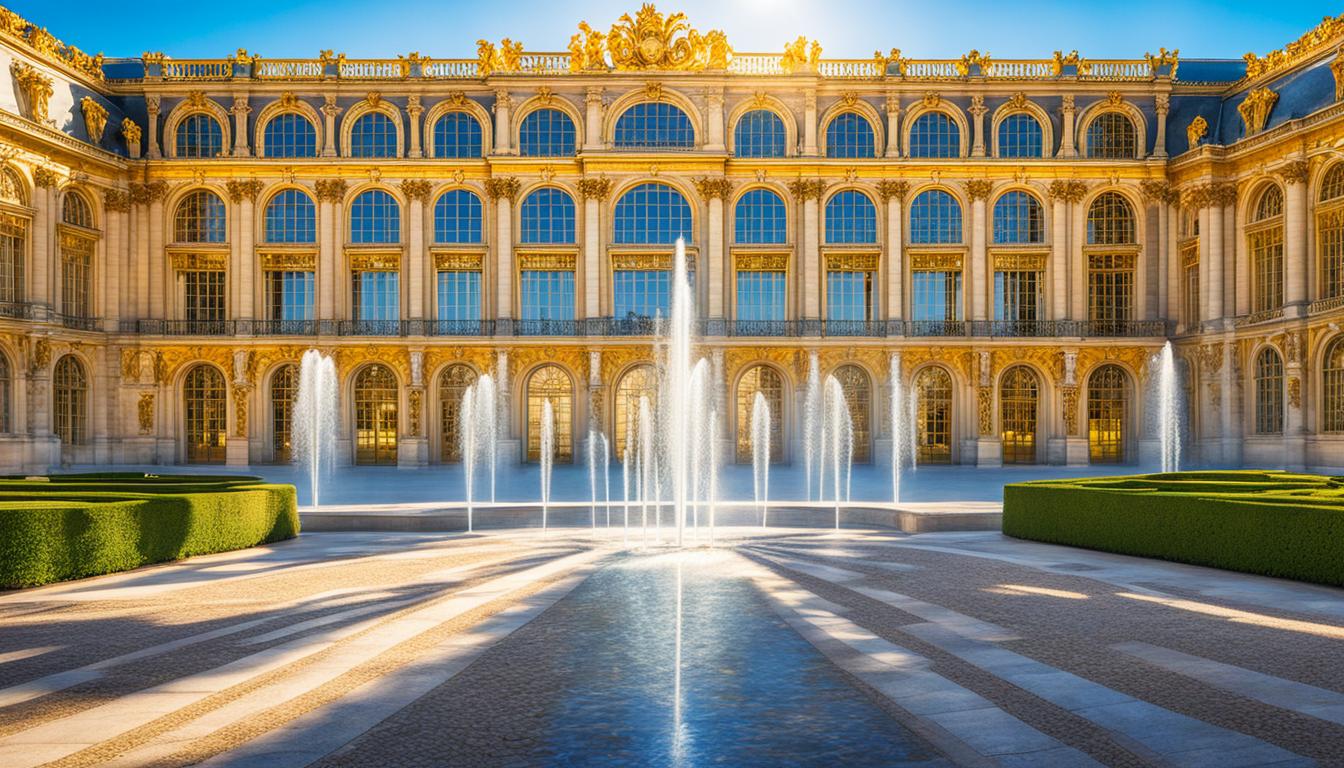Step Back in Time: Explore These Historical Landmarks in France!
What stories lie hidden within the intricate architecture and iconic landmarks that dot the French landscape? From the grandeur of the Palace of Versailles to the soaring spires of Notre-Dame Cathedral, France’s historical wonders offer a captivating glimpse into the nation’s rich past1. As the most visited museum in the world, the Louvre in Paris welcomes over 9 million annual visitors eager to uncover the secrets of its remarkable collections1. Whether marveling at the Eiffel Tower’s impressive 1,083-foot height1 or discovering the awe-inspiring stained glass of Sainte-Chapelle1, these landmarks have the power to transport us through the ages and reveal the stories that have shaped France’s enduring legacy.
Key Takeaways
- Explore the opulent grandeur of the Palace of Versailles and its stunning gardens
- Marvel at the soaring Gothic splendor of Notre-Dame Cathedral and its intricate architecture
- Discover the natural and prehistoric wonders of France, from the iconic Mont Saint-Michel to the Palais Ideal
- Uncover the stories behind France’s UNESCO World Heritage sites and historic towns
- Experience the country’s rich heritage and culture through its renowned landmarks and monuments
Opulent Royal Palaces and Gardens
The Palace of Versailles stands as one of France’s most iconic and opulent landmarks, a testament to the grandeur of the French monarchy. Commissioned by Louis XIV, the “Sun King,” the palace was transformed from a humble hunting lodge into a shimmering symbol of absolute power and divine kingship2. Visitors can marvel at the breathtaking Hall of Mirrors, where the French court once dazzled, and explore the private chambers of Marie Antoinette, the ill-fated queen whose story is forever intertwined with the lavish excesses of Versailles2. Surrounded by meticulously manicured gardens and fountains, the Palace of Versailles offers a glimpse into the lavish world of France’s former rulers and remains one of the most popular tourist destinations in the country2.
Beyond the opulence of Versailles, France boasts a wealth of other royal palaces and gardens that captivate visitors. The Louvre Museum, initially intended to reinforce the walls constructed to protect Paris against invasions, became a royal residence in the 14th century for King Charles V3. The Palais-Royal, previously a royal palace, now houses the French Ministry of Culture among other institutions, while the Tuileries Palace was set on fire by the Paris Commune in 1871 and subsequently demolished3. The stately Élysée Palace has been the official residence of the French Head of State since the Franco-Prussian War, and the Palais du Luxembourg, built for Marie de’ Medici, now serves as the home of the French Senate3.
These opulent royal palaces and their meticulously manicured gardens offer a glimpse into the lavish world of France’s former rulers, providing visitors with a unique opportunity to step back in time and explore the rich history and grandeur of the French monarchy2. Whether strolling through the Hall of Mirrors at Versailles or admiring the stunning architecture of the Louvre, these remarkable landmarks continue to captivate and inspire travelers from around the world23.
Historical Landmarks in France: Cathedrals and Basilicas

France is home to some of the world’s most iconic and historically significant cathedrals and basilicas. Chief among them is the magnificent Notre-Dame Cathedral, a breathtaking example of Gothic architecture that has stood as a symbol of Paris for centuries4. Visitors can admire the cathedral’s intricate façade, gaze upon the stunning rose windows, and even climb to the top of the towers for panoramic views of the city5. Just a short distance from Notre-Dame, the Sainte-Chapelle is another must-visit landmark, with its stunning stained-glass windows that bathe the interior in a kaleidoscope of colors4. This 13th-century chapel was commissioned by King Louis IX to house precious Christian relics, and its stunning Gothic design continues to captivate visitors today4.
France’s rich medieval architecture is on full display in these iconic Paris landmarks4. With their ornate facades, vaulted ceilings, and awe-inspiring stained glass, these cathedrals and basilicas offer a glimpse into the country’s storied past and the enduring legacy of its Gothic architecture4. Whether you’re marveling at the grandeur of Notre-Dame or immersing yourself in the ethereal beauty of Sainte-Chapelle, these historic structures are sure to leave a lasting impression on any visitor to France645.
Picturesque Towns and Medieval Citadels

Beyond the glittering landmarks of Paris, France is home to a wealth of picturesque towns and medieval citadels that offer a glimpse into the country’s rich history. In the northeastern city of Strasbourg, the UNESCO-listed Grande Île district is an enchanting maze of timber-framed houses, winding streets, and the magnificent Strasbourg Cathedral, a Gothic masterpiece7. The city is especially renowned for its annual Strasbourg Christmas markets, which transform the historic center into a festive wonderland7.
Farther north, the iconic Mont Saint-Michel stands as one of France’s most recognizable landmarks, a medieval monastery perched atop a rocky island that can only be accessed on foot during low tide7. This awe-inspiring fortress, with its towering spires and fortified walls, is a testament to the ingenuity and resilience of French engineering and medieval architecture7.
Throughout Normandy and other regions, France is dotted with picturesque fortified towns and medieval citadels that have withstood the test of time7. These bastions of history, such as Provins, Pérouges, Yvoire, Loches, Vaison-la-Romaine, and Châteauneuf-en-Auxois, offer visitors a chance to step back in time and explore the country’s captivating medieval past7.
From the enchanting Christmas markets of Strasbourg to the awe-inspiring Mont Saint-Michel, France’s picturesque towns and medieval citadels are a testament to the country’s rich cultural heritage and enduring architectural legacy7. Immerse yourself in the timeless charm of these historic destinations and discover the essence of France’s captivating past7.
Natural and Prehistoric Wonders

France’s historical legacy extends far beyond its renowned landmarks and cities, with a wealth of natural and prehistoric wonders scattered throughout the countryside. In the Dordogne region, the Vézère Valley is home to an astounding 147 prehistoric sites, including the famous Lascaux cave paintings, which offer a glimpse into the dawn of human civilization8. These caves, housing over 600 paintings from the Upper Palaeolithic period, receive up to 1500 visitors daily8. Farther north, the Loire Valley is a breathtaking stretch of land dotted with fairy-tale châteaux, picturesque towns, and the winding waters of the Loire River. This UNESCO-listed region was a major trading hub in medieval France and is renowned for its rich cultural heritage and stunning natural beauty.
From the awe-inspiring cave paintings to the stately chateaux that dot the landscape, these natural and prehistoric landmarks reveal the diverse tapestry of France’s history. The Vézère Valley’s prehistoric sites8, combined with the Loire Valley’s breathtaking châteaux, offer visitors a unique opportunity to step back in time and immerse themselves in the country’s remarkable natural and cultural wonders8.
Conclusion
France’s remarkable historical landmarks are a testament to the enduring legacy of this captivating country. From the opulent grandeur of Versailles to the serene beauty of Mont-Saint-Michel, these iconic sites offer visitors a chance to step back in time and immerse themselves in the rich cultural and architectural heritage of France9.
Whether you’re marveling at the soaring Gothic cathedrals, exploring the picturesque towns and medieval citadels, or uncovering the natural and prehistoric wonders of the French countryside, a journey through these historical landmarks is a truly unforgettable experience9. As you travel through France, you’ll uncover the stories that have shaped this nation, gaining a deeper appreciation for the country’s enduring influence on the world.
With France’s tourism industry thriving, welcoming a record 89.4 million foreign visitors in 2018 and aiming to reach 100 million by the end of the 2020s decade, the country’s historical landmarks continue to captivate and inspire travelers from around the globe9. As a leading agricultural producer and industrial power, France has long been a significant player on the international stage, further enhancing the allure of its cultural and historical offerings10.







